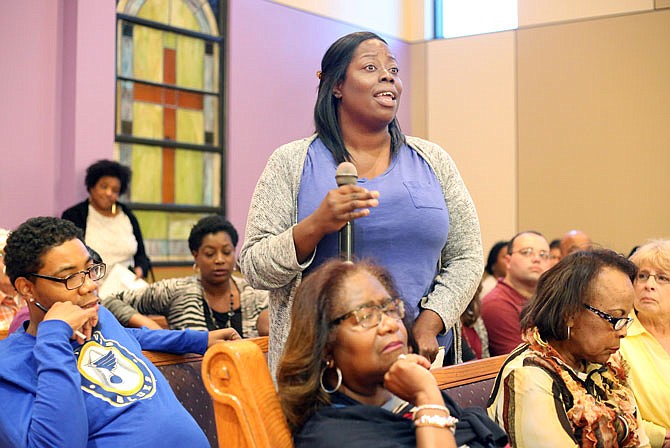The pews of Quinn Chapel A.M.E. Church were nearly full Wednesday night - not for a worship service, but for voices and experiences to be acknowledged by local institutions at the beginning of a long and long-awaited journey toward progress on racial disparity in Jefferson City.
The panel at the front of the church consisted of two tables. Boys & Girls Club of the Capital City's Director of Operations Christopher Sutton, Jefferson City Public Schools Board of Education member Michael Couty and JCPS Superintendent Larry Linthacum were at one. Missouri and local NAACP President Rod Chapel, Quinn Chapel A.M.E.'s Rev. Cassandra Gould and 5th Ward City Councilman Larry Henry were at the other table.
Susan Cook-Williams was the moderator, but the night was about much more than questions fielded by the panel.
The most passionate and raw emotions came from crowd members given a chance to speak about issues people of color in the community face - and not exclusively at school.
Wednesday's town hall meeting is the first of three planned and independent of future school district-sponsored community outreach events. The next meeting is scheduled for 6:30 p.m. Oct. 9 at One in Christ Baptist Church.
That's the same date and time as a JCPS school board meeting, but Superintendent Larry Linthacum assured the audience the district will have its own series of meetings to address issues brought to light last week by a racist photo circulated on social media and involving three Jefferson City High School students.
The incident spurred Wednesday's meeting to come together in what organizers hoped would start an overdue conversation about disparities in the community and what can specifically be done to resolve them.
"We will not heal in the next two hours," Cook-Williams said at the start. While acknowledging "there are no quick fixes," she added Jefferson City's children are looking for leadership.
The leadership seated on the panel or in the pews represented many of the major public institutions in Jefferson City - public schools, law enforcement and the criminal justice system, and city government.
Those leaders heard from many people in the community about their experiences, the pain and burdens they bring to conversations.
"In order to talk about inequities," community members must learn where people are coming from, Couty said.
There were concerns students in the public schools are not receiving enough education about black history, and many were concerned too that the identities and backgrounds of teachers and administrators in the district don't adequately represent the diversity of the student body.
Raymond Gray advocated the district's hiring process needs to change in order to build the foundation of a more diverse staff. Gray was not alone in that criticism.
Kennette Goodman shared how she felt she had been given a token run-around in the hiring process and had multiple applications denied.
Two mothers who shared their contact information with each other after the meeting - one white and one black - highlighted the disparities between disciplinary consequences for their children. One said her child had physically injured another student and received no punishment, while the other said her son made a verbal threat and received an eight-day suspension.
The school-to-prison pipeline - a national concern that racial disparities in discipline at schools disproportionately send students of color into the criminal justice system - came up, as well.
There were a lot more questions and concerns than answers. At times, members of the audience felt Linthacum in particular didn't seem connected to what was going on in the district on the level of students, teachers and principals.
He acknowledged he could do better, though other members of the panel pointed out conditions in the community of socio-economic inequities and the legacies of historical racism he inherited were not of his making.
Still, as Chapel and Gould in particular put it, people don't want any more excuses, just meaningful actions.
"The goal was to engage with parents and community members," Linthacum said after the meeting, and he felt that was accomplished. After the meeting, he was seen speaking with Goodman and the two mothers in particular.
"We're going to consider all options," he said of what processing all the community input and turning it into tangible policy will look like - be it committees, board meetings, both or something else entirely. He added he doesn't want meetings for meetings' sake.
"We need to take that in and take some important time to consider what we heard," school board President Steve Bruce said after the meeting. "Their experiences are nothing I am used to," he said referring to the backgrounds of people of color in the community.

